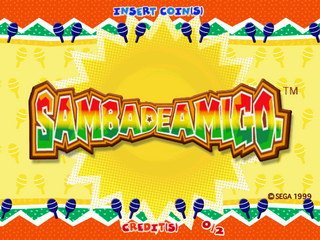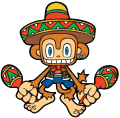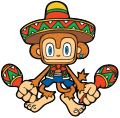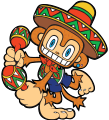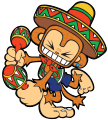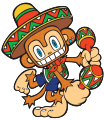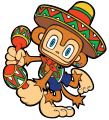Difference between revisions of "Samba de Amigo"
From Sega Retro
m |
|||
| Line 197: | Line 197: | ||
{{SambadeAmigo}} | {{SambadeAmigo}} | ||
| − | |||
| − | |||
Revision as of 18:56, 6 July 2018
| This article needs to be rewritten to too sloppy, needs to be rewritten by someone more informed. This article needs to be rewritten to conform to a higher standard of article quality. After the article has been rewritten, you may remove this message. For help, see the How to Edit a Page article. |
- For the Wii game, see Samba de Amigo (Wii).
| Samba de Amigo | ||||||||||||||||||||||||||||||||||||||
|---|---|---|---|---|---|---|---|---|---|---|---|---|---|---|---|---|---|---|---|---|---|---|---|---|---|---|---|---|---|---|---|---|---|---|---|---|---|---|
| System(s): Sega NAOMI, Sega Dreamcast | ||||||||||||||||||||||||||||||||||||||
| Publisher: Sega | ||||||||||||||||||||||||||||||||||||||
| Developer: Sonic Team | ||||||||||||||||||||||||||||||||||||||
| Peripherals supported: Dreamcast VGA Box, Samba de Amigo Maracas | ||||||||||||||||||||||||||||||||||||||
| Genre: Action | ||||||||||||||||||||||||||||||||||||||
| Number of players: 1-2 | ||||||||||||||||||||||||||||||||||||||
| ||||||||||||||||||||||||||||||||||||||
Samba de Amigo (サンバ DE アミーゴ) is a video game developed by Sonic Team. It was originally released in 1999 by Sega for the Sega NAOMI arcade platform, before seeing a port to the Sega Dreamcast a year later. The Dreamcast version was designed to be used with the Samba de Amigo Maracas.
Contents
Gameplay
A rhythm video game similar in theme to Dance Dance Revolution, Samba de Amigo is played with a pair of maracas. As a song plays, the player (guided by on-screen graphics) must shake the maracas at high, middle, or low heights with the beat of the music, or occasionally must strike poses with the maracas held in various positions. The player is represented on-screen by a grinning monkey with a square head and a sombrero, Samba. If the player does well, the scene around Samba (usually a concert or a dance) will attract more people and become more vividly animated; if the player does poorly, characters leave and eventually all that's left is the monkey alone, looking sad.
In the primary game mode, each player has six spots arranged in a circle on the screen: two red meaning 'shake high,' two yellow meaning 'shake middle,' and two green meaning 'shake low.' Blue dots will appear in the center of this circle and move towards the spots; as soon as the blue dot touches a spot, the player must shake a maraca at that location. For example, if a blue dot touches the upper left spot, the player must shake either maraca above his left shoulder. Occasionally a long line of dots will flow into a spot and the word 'Shake' appears, telling the player to continue shaking his maraca rapidly there. Sometimes a stick-figure (named "Pose-kun") appears on the screen holding its maracas in a certain position; the player has a second or two to match the figure's pose for points.
Songs in the game (mostly covers) include "Macarena," "Mas Que Nada," "Soul Bossa Nova," A-ha's "Take On Me", Chumbawamba's "Tubthumping," Ricky Martin's "Livin' La Vida Loca" and "Cup of Life," and "El Ritmo Tropical" (which also appeared in Dance Dance Revolution).
History
Sequels and re-releases
Samba de Amigo has not seen any direct "sequels", but has had a number of updates over the years. The first being Samba de Amigo Ver. 2000, also on Sega NAOMI hardware and the Sega Dreamcast.
A Wii version was released in 2008.
Awards
Samba de Amigo was named Best Puzzle Game of 2000 by GameSpot. It also was nominated for the Excellence in Audio award and for a Game Spotlight Award in the 1st annual Game Developers Choice Awards.
Versions
Dreamcast version adds a "party mode," with minigames such as Guacamole (pronounced and played much the same as "whack-a-mole"), Strike A Pose (consisting of a long sequence of poses to make), and 1-2-Samba! (where spots must be hit in sequence - the Japanese version's name for this minigame, "Ichi Ni San-ba," is a pun on counting to three in Japanese). The home version also has features which can be unlocked, such as sound effects and hidden songs. Hidden songs include themes from other Sega games such as Sonic Adventure and OutRun.
For Dreamcast version, the Sega maracas controllers are red, and the rattle part can be unscrewed from the top of each for quieter play. Each maraca has a cord which is plugged into to a bar that lays in front of the player's feet. The bar is slightly more than two feet in length and has a sensor at each end, and each maraca has an infrared transmitter mounted on its cord; presumably this allows the system to triangulate the position of each maraca as the player holds it. The game can also be played with the standard Dreamcast controller, but this makes the game trivial to play.
Production credits
NAOMI version
- Executive Supervisor: Isao Okawa
- Executive Producer: Shoichiro Irimajiri
- Executive Manager: Hisashi Suzuki
- Producer: Yuji Naka
- Director: Shun Nakamura
- Project Manager: Tomoji Miyamoto, Yukifumi Makino
- Character Designer: Yuji Uekawa
- Technical Programmer: Takahiro Hamano
- Main Planner: Shun Nakamura
- Planner: Tomohiko Aita
- Designers: Satoshi Okano, Hiroyuki Watanabe, Mino Bonkohara
- Programmers: Yoshitaka Kawabata, Masaaki Sawada, Takahiro Hamano
- Sound Director: Fumitaka Shibata
- Sound Creator: Masaru Setsumaru
- Material Supervisor: Masao Yoshimoto, Seiji Ishii
- Mechanical Engineer: Yutaka Yokoyama
- Electrical Engineer: Mitsuru Kawamura, Hideyuki Yamada
- Cabinet Designer: Kimio Tsuda
- Created By: Sonic Team
- Presented By: Sega
Dreamcast version
- Executive Producer: Shoichiro Irimajiri
- Project Manager: Shuji Utsumi
- Producer: Yuji Naka
- Director&Main Planner: Shun Nakamura
- Character Designer: Yuji Uekawa
- Technical Programmer: Takahiro Hamano
- Planner: Tomohiko Aita
- Programmer: Yoshitaka Kawabata, Masaaki Sawada
- Designer: Satoshi Okano, Hiroyuki Watanabe, Miho Bonkohara
- Sound Coordination: Yukifumi Makino
- Sound Director: Fumitaka Shibata
- Sound Creator: Masaru Setsumaru
- Executive Manager: Hisashi Suzuki, Nobuhisa Yamada
- Marketing: Hideki Okamura, Kunihisa Ueno, Seijiro Sannabe, Toyohisa Hiwatari
- Promotion: Masatoshi Kawaguchi, Hiroto Kikuchi, Shunichi Kobayashi
- Publicity: Tadashi Takezaki, Yasushi Nagumo, Hiromichi Hisada
- Monitor Test: Tsuyoshi Sawada, Hitomi Oka
- Package&Manual: Kaoru Ichigozaki, Takashi Nishimura, Chieko Nakamura
- Maracas Controller: Kazuhiko Hamada, Kenji Tosaki, Atsunori Himoto, Shigeyoshi Sue, Shinichi Ino, Hirokazu Hama, Junichiroh Maeji, Takashi Koakutsu, Yusuke Jibiki, Kyoko Ando
- Special Thanks: Kimitaka Nishio, Kenichi Shiraishi, Takayuki Suzuki, Teruhito Uchida, Satoshi Kuwano, Masayuki Baba, Naoto Numada, Eisuke Hayashi, Toshiaki Nakamura, Keisuke Yoda, Tatsushi Hirose, Hiroshi Kitagawa, Hideki Yohkaichiya, Hisako Saegusa
- Executive Supervisor: ISAO OOKAWA
- Presented by: Sega
© Sega Enterprises, Ltd., 1999,2000
Magazine articles
- Main article: Samba de Amigo/Magazine articles.
Artwork
(colour errors from EPS -> SVG conversion)
Physical scans
NAOMI version
| NAOMI, World |
|---|
|
Dreamcast version
| Sega Retro Average | |||||||||||||||||||||||||||||||||||||||||||||||||||||||||||||||||||||||||||||||||||||||||||||||||||||||||||||||||||||||||||||||||||||||||||
|---|---|---|---|---|---|---|---|---|---|---|---|---|---|---|---|---|---|---|---|---|---|---|---|---|---|---|---|---|---|---|---|---|---|---|---|---|---|---|---|---|---|---|---|---|---|---|---|---|---|---|---|---|---|---|---|---|---|---|---|---|---|---|---|---|---|---|---|---|---|---|---|---|---|---|---|---|---|---|---|---|---|---|---|---|---|---|---|---|---|---|---|---|---|---|---|---|---|---|---|---|---|---|---|---|---|---|---|---|---|---|---|---|---|---|---|---|---|---|---|---|---|---|---|---|---|---|---|---|---|---|---|---|---|---|---|---|---|---|---|
|
| 85 | |
|---|---|
| Based on 27 reviews | |
External links
- Sega of Japan catalogue pages (Japanese): Dreamcast
References
- ↑ http://sega-interactive.co.jp/special/history/title/sambadeamigo.html
- ↑ Press release: 2000-10-17: Sega Delivers a Fiesta of Fun to Dreamcast Players With Samba de Amigo
- ↑ 3.0 3.1 3.2 File:CVG UK 231.pdf, page 108 Cite error: Invalid
<ref>tag; name ":File:CVG UK 231.pdf_p108" defined multiple times with different content - ↑ 4.0 4.1 File:ConsolesPlus FR 108.pdf, page 72 Cite error: Invalid
<ref>tag; name ":File:ConsolesPlus FR 108.pdf_p72" defined multiple times with different content - ↑ 5.0 5.1 File:CVG UK 225.pdf, page 126 Cite error: Invalid
<ref>tag; name ":File:CVG UK 225.pdf_p126" defined multiple times with different content - ↑ 6.0 6.1 File:Dorimaga JP 20021011 2002-18.pdf, page 33 Cite error: Invalid
<ref>tag; name ":File:Dorimaga JP 20021011 2002-18.pdf_p33" defined multiple times with different content - ↑ 7.0 7.1 File:Edge UK 086.pdf, page 94 Cite error: Invalid
<ref>tag; name ":File:Edge UK 086.pdf_p94" defined multiple times with different content - ↑ 576 Konzol, "Április 2001" (HU; 2001-xx-xx), page 42
- ↑ Alaab Alcomputtar, "" (SA; 2001-xx-xx), page 31
- ↑ Click!, "4/2001" (PL; 2001-02-15), page 49
- ↑ Consoles Max, "Janvier 2001" (FR; 200x-xx-xx), page 96
- ↑ DC-UK, "August 2000" (UK; 2000-07-06), page 84
- ↑ Dreamcast Magazine, "No. 16" (UK; 2000-11-30), page 48
- ↑ Electronic Gaming Monthly, "January 2001" (US; 2000-12-05), page 195
- ↑ Entsiklopediya igr dlya Dreamcast, "Izdaniye chetvertoye, dopolnennoye" (RU; 2002-xx-xx), page 193
- ↑ Fun Generation, "07/2000" (DE; 2000-06-21), page 92
- ↑ GameFan, "Volume 8, Issue 7: July 2000" (US; 2000-xx-xx), page 18
- ↑ GameFan, "Volume 8, Issue 12: December 2000" (US; 2000-1x-xx), page 25
- ↑ GamePro, "January 2001" (US; 200x-xx-xx), page 107
- ↑ Game Informer, "December 2000" (US; 2000-1x-xx), page 126
- ↑ Gamers' Republic, "December 2000" (US; 2000-xx-xx), page 92
- ↑ MAN!AC, "01/2000" (DE; 2000-12-06), page 78
- ↑ Mega Fun, "09/2000" (DE; 2000-08-02), page 62
- ↑ Next Generation, "August 2000" (US; 2000-07-18), page 90
- ↑ Official Dreamcast Magazine, "January 2001" (UK; 2000-11-30), page 68
- ↑ Official Dreamcast Magazine, "Holiday 2000" (US; 2000-11-28), page 94
- ↑ Sega Magazin, "September 2000" (DE; 2000-07-31), page 20
- ↑ Strana Igr, "Sentyabr 2000 2/2" (RU; 2000-xx-xx), page 20
- ↑ Video Games, "01/2001" (DE; 2000-12-06), page 64
| Games in the Samba de Amigo Series | |
|---|---|
| Samba de Amigo (1999) | Samba de Amigo Ver.2000 (2000) | |
| Samba de Amigo (2001) | Samba de Amigo (2002) | Amigo-kun no Doki Doki Aishou Check (2002) | |
| Samba de Amigo (2008) | |
| Samba de Amigo: Party Central (2023) | |
| Samba de Amigo: Party-To-Go (2023) | |
| Samba de Amigo related media | |
| Samba de Amigo Presents Samba de Janeiro Non-Stop Best of Bellini (2000) | Samba de Amigo (2001) | Samba de Amigo Original Songs Collection ~Party! Party! Party!~ (2023) | |
| Samba de Amigo The Greatest Guidebook (2000) | |
- Pages with reference errors
- Pages Needing to be Rewritten
- Dreamcast VGA Box-compatible games
- 1-2 player games
- All arcade games
- Dead external reference
- NAOMI games
- 1999 NAOMI games
- All 1999 games
- JP Dreamcast games
- All JP games
- US Dreamcast games
- All US games
- EU Dreamcast games
- All EU games
- Dreamcast games
- 2000 Dreamcast games
- All 2000 games
- Dreamcast action games
- All action games
- Old content rating field
- All games
- Credits without source
- Credits without reference
- Old-style rating (consolesmax)
- Rating without PDF source
- Old-style rating (consolesplus)
- Use magref
- Old-style rating (cvg)
- Old-style rating (dcuk)
- Old-style rating (dmjp r)
- Old-style rating (edge)
- Old-style rating (egm)
- Rating without source
- Old-style rating (gamefan)
- Old-style rating (gamepro)
- External rating reference
- Update source
- Old-style rating (gamesmaster)
- Update ratings template
- 10 old ratings
- Samba de Amigo (franchise)
